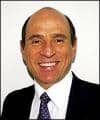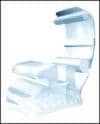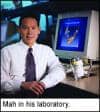by Alfredo Gilbert, DDS, MS
A univeral instrument for transferring lingual brackets
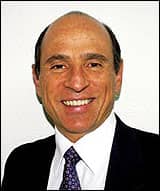
There are several reasons why lingual brackets must be bonded indirectly.1 Only indirect bonding can guarantee correct positioning of the brackets. A few indirect positioning systems have proven to be effective and precise. Particularly notable are the Hiro system,2 in which a real setup model is made, and the Ray-Set system,3 in which the setup is virtual. Both of these systems are appropriate for cases involving significant adjustments to the occlusion, for example by means of tooth extractions.
Simple cases in which the orthodontist decides to work without a setup also require the use of a reliable positioning and transfer system. Positioning should be indirect so as to avoid the unsatisfactory dental movements associated with imprecise bracket positioning.4
In this article I will present an instrument designed to transfer any brand of lingual bracket from the dental model to the lingual surface of the teeth in those cases in which a setup has not been created.
Why Indirect Positioning Is Key in Lingual Orthodontics
The morphology of the lingual surface of the teeth is irregular.5 Normally, the buccolingual width of the upper canines is greater than that of the four upper incisors. This means that we need to standardize the buccolingual widths if we want to work with the straight wire technique and avoid compensations as much as possible.6 Consequently, positioning of lingual brackets is not done in the same way as in the labial indirect bonding technique, where the brackets are simply bonded to the model and then transferred with a transfer tray. In the lingual technique we must also standardize the buccolingual widths and regularize the imperfections in the lingual surface.7
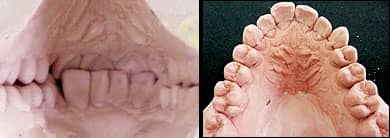
Figure 1: Starting with models
The Hiro System
Toshiaki Hiro, DDS, PhD, MOrth RCSEd, EBO,WBLO, designed a system that effectively standardizes and regularizes the lingual surfaces. In the Hiro system, the occlusion is corrected in the setup model and an ideal archwire that perfectly adjusts to the model is made.
The archwire, with the lingual brackets attached, is then brought to the model and the spaces between the brackets and the model are filled with resin. The amount of resin required and the form that the resin takes depends on the buccolingual and mesiodistal inclination (torque and tip, respectively) of the tooth in question. This variation in the quantity and form of the resin standardizes the buccolingual widths and gives information to the brackets, thus avoiding the need to include compensatory bends in the archwire.

Figure 2: Determining the widest tooth
The Ray-Set System
The Ray-Set appliance, designed by Piero Biaggini in collaboration with Birte Mielsen, DDS, PhD, Dr Odont, consists of a tray with three calibrators. One calculates rotations, another calculates buccolingual positions, and a third indicates the mesiodistal positions. The appliance makes use of a laser beam to obtain the Q, or 0º, point (the center of the clinical crown in straight wire systems8); thus the name Ray-Set. The Q point is the point at which the laser beam does not produce a shadow.
Because it does not require the models to be cut, the Ray-Set system is practical for those orthodontists who do not have enough space to install a laboratory.
How Lingual Brackets Are Transferred
Ideally, lingual brackets should be transferred individually so as to achieve the greatest precision possible during positioning. Additionally, individual transfer is more comfortable for the clinician and more versatile in terms of rebonding.
The transfer system proposed by Hiro uses a glass ionomer base, while the system most often used in conjunction with the Ray-Set uses double, separable acetates.
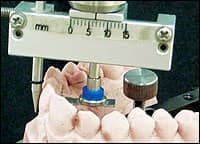
Figure 3: Verifying buccolingual width
As with the indirect bonding of labial brackets, the precision with which lingual brackets are bonded is directly proportional to the precision of the bracket transfer system.9
Other Considerations
The quantity of resin required to standardize the buccolingual widths of the anterior teeth and to “smooth” the irregularities usually found on the lingual surface of the teeth greatly complicates bracket transfer. The clinician may have difficulties locating the bonding position because the lingual surface of the tooth is not easy to see—nor is it easy to access. The lingual region tends to be wetter and more easily contaminated than the labial.
Both the Hiro and Ray-Set systems are based on the bonding of lingual brackets after a setup, whether real or virtual, has been made. I have created a transfer system designed for those cases in which a setup has not been made.

Figure 4: Leaving room for the instrument
Positioning Brackets Without a Setup Model
Several orthodontic companies produce and market brackets for cases that are variously described as “simple,” “social,” or “relapse.” Although I do not particularly agree with this terminology (after all, who determines the degree of difficulty of an orthodontic case, and how?), it is a fact that such brackets exist and are being used to solve orthodontic problems. Companies that market such brackets often suggest that the brackets be bonded directly. Following such advice could greatly complicate “simple” cases.
Even if the orthodontist has decided that a particular case is “simple” and does not require a setup, it is still necessary to transfer the brackets from the models to the lingual surface of the teeth using a transfer system that respects the vertical and mesiodistal positions of the prescription. This allows for the standardization of the buccolingual widths of the anterior teeth, thereby preventing iatrogenias. It is for this purpose that I have designed the instrument described below.
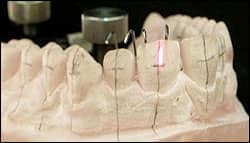
Figure 5: Reaching the center of the labial surface
The Transfer Instrument
This instrument permits indirect bonding of the brackets and works by means of a section of steel wire that is angled from the vestibular surface of the tooth to the lingual surface, where it is inserted into the bracket to be bonded. The instrument is supported and stabilized on the labial surface by the placement of a plastic gel. The gel prevents movement and facilitates manipulation during bonding.
To achieve standardization of the anterior segments in both arches, we select the widest tooth of the arch (usually the canine), then measure and record the distance from the forwardmost part of the bracket to the center of the clinical crown on the labial side. All of the guides should be calibrated to the same width in order to avoid the need to compensate during treatment. To achieve this standardization, we use a digital calibrator.

Figure 6: Stabilizing with transfer gel
Once impressions have been taken and dental models made with a Velmix-type plaster, we select the point of force application, taking into consideration the diagnostic principles particular to each case (Figure 1). The next step is to determine the widest tooth of the arch. Although the canine is usually the widest tooth (Figure 2), is it essential to thoroughly check which tooth should be chosen as the “guide” tooth, because, on occasion, the incisors have a greater buccolingual width (Figure 3).
Once the widest tooth has been selected, we begin to manufacture the guide by bending a section of rectangular .017 × .025 wire. We insert one end of the wire into the slot of the bracket and bend the wire at a 90º angle toward the incisal edge of the tooth. The end should exceed the incisal edge by approximately 5 mm, a distance long enough to allow comfortable manipulation of the instrument (Figure 4).
Buccolingually, the wire should be long enough to reach the center of the labial surface (Figure 5) and to be able to create a 90º bend at the Q point. We stabilize the guide using a transfer gel such as Dentsply Caulk’s Triad Gel (Figure 6).
The novel bracket transfer system (Figure 7) presented here is able to control the buccolingual widths of the anterior teeth and the mesiodistal and buccolingual angles in both arches, and thus avoids the need for compensation bends.
It is worth repeating that this instrument can be used with any brand of lingual bracket (Figure 8). I hope that this feature will help orthodontists to avoid the costs of buying different transfer systems for different brackets. The orthodontist is thus free to choose the most appropriate brackets for the case, and is not limited by the lack of a corresponding transfer system (Figure 9).
The purpose of this invention is to provide an instrument that is different from the products currently available, that allows brackets to be positioned with great precision, that is comfortable for the operator to use, and that may be used with any brand of brackets.
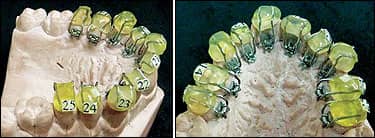
Figure 7: The bracket transfer system

Figure 8: A diagram of the system
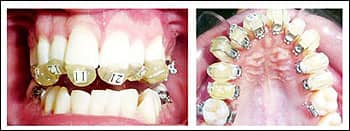
Figure 9: The system works with any bracket
Alfredo Gilbert, DDS, MS, is a guest professor of lingual orthodontics at the Hospital Infantil du Mexico Federico Gomez and the academic coordinator of lingual orthodontics at the Facultad de Estudios Superiores of the Universidad Nacional AutÓnoma de MÉxico. He is the author of Lingual Orthodontics: The Truly Invisible Orthodontics, and teaches a hands-on lingual course at NYU. He can be reached at
REFERENCES
- Aguirre MJ. Indirect bonding for lingual cases. J Clin Orthod. 1984;18:565-569.
- Hiro T. Resin core indirect bonding system: improvement of lingual orthodontics. Japan Orthod Society. 1998; 57(2):83-91.
- Melsen B, Biaggini P. The Ray Set: A new technique for precise indirect bonding. J Clin Orthod. November 2002
- Festa F, Grippaudo C. Influenza delle variazioni anatomiche dentali sul posizionamiento degli attacchi. Mondo Ortodontico. 1990;15:667-670.
- Ash M, Nelson S. Anatomy, Physiology and Dental Occlusion. Elsevier, 2004.
- Scuzzo G, Takemoto K. Lingual laboratory procedures. In: Invisible Orthodontics. Quintessenz Verlag, 2003.
- Echarri Lobiondo P. Procedimiento para el posicionamiento de brackets en tÉcnica lingual. 1ª EdiciÓn Barcelona: Ladent SL, 1995
- Andrews LF. Straight wire: The Concept and the Appliance. Los Angeles; Wells Co, 1989.
- Gilbert RA, Meneses A. A new transfer system for the indirect cementation of brackets. J Mexican Dent Assoc. 2006;63 (6):235-237.

